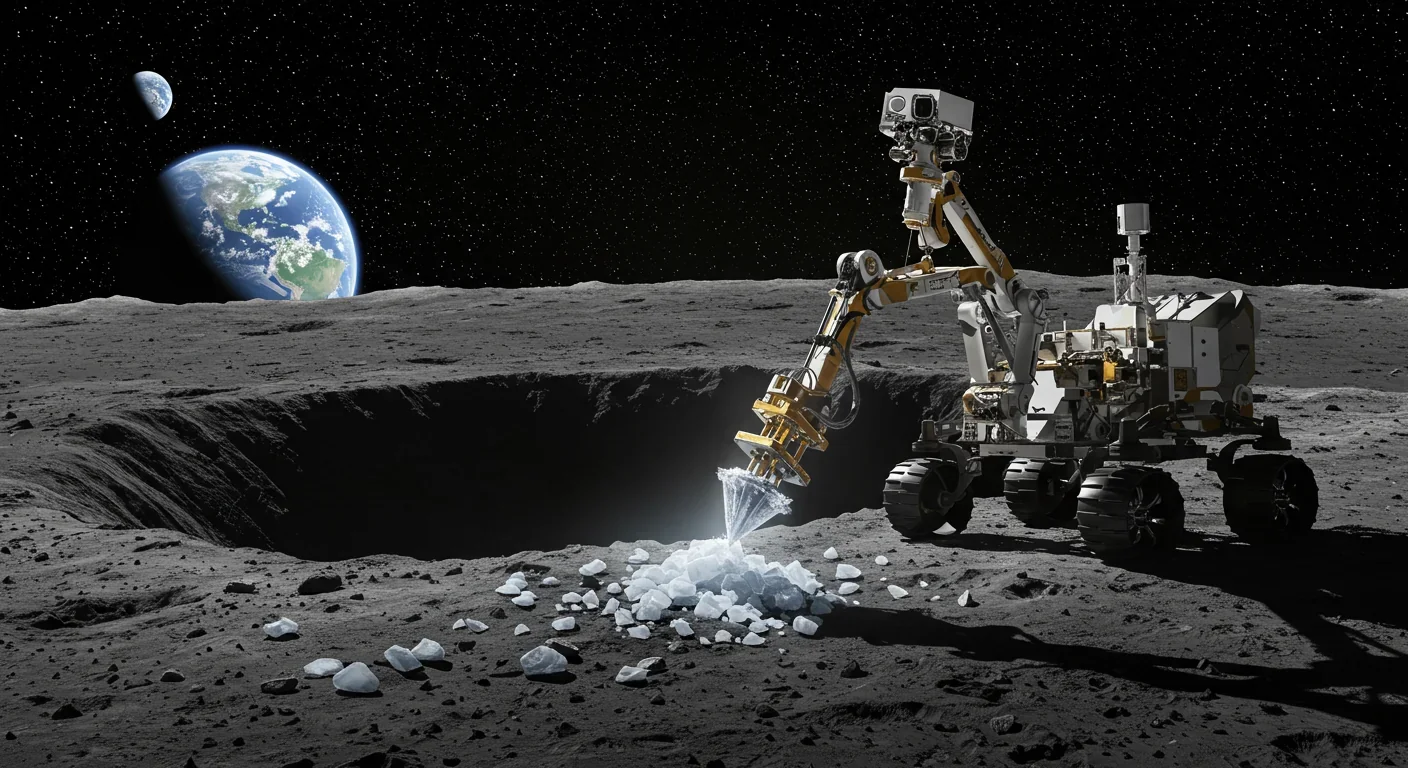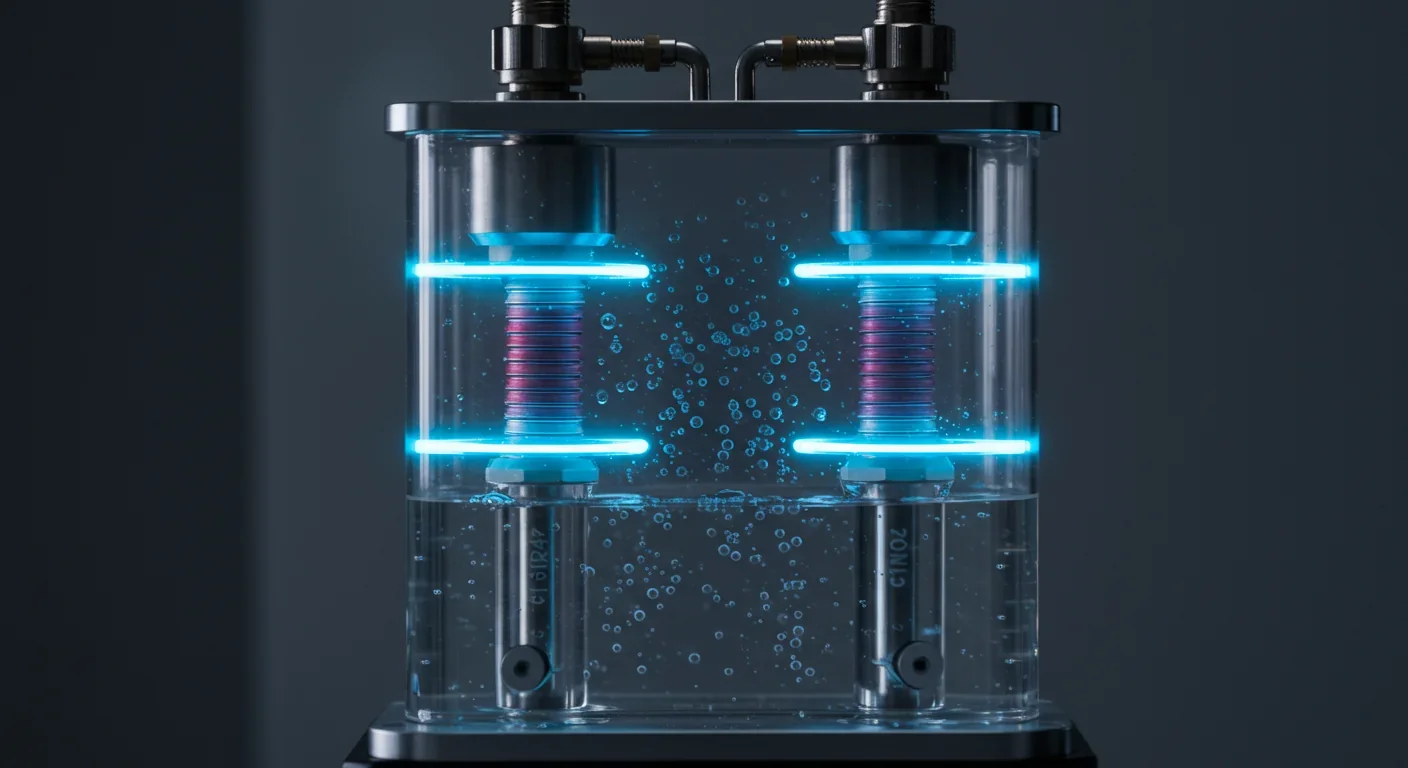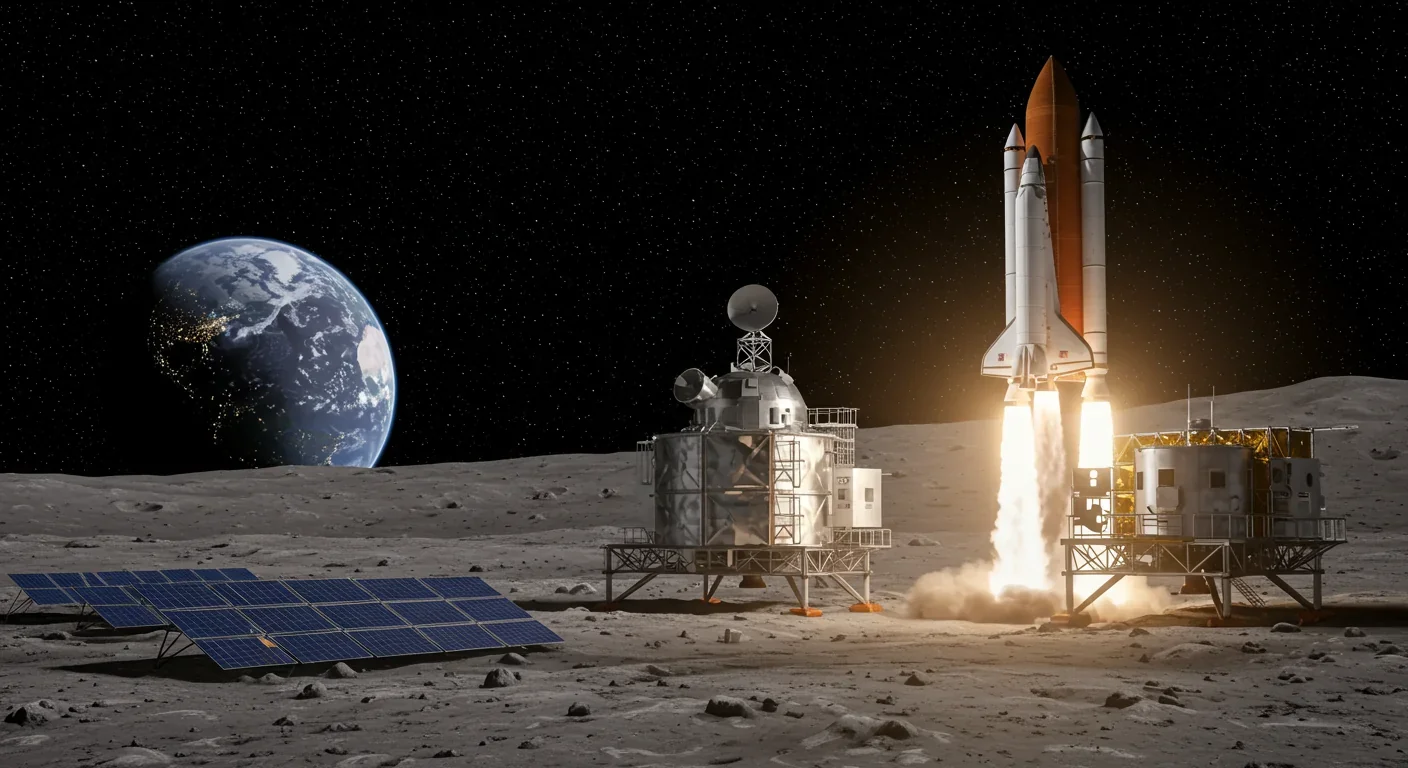Fusion Rockets Could Reach 10% Light Speed: The Breakthrough

TL;DR: Water ice trapped in lunar polar craters can be extracted and converted into rocket propellant, slashing space mission costs and enabling sustainable exploration beyond Earth.

Within the next decade, astronauts could be refueling spacecraft on the Moon using water extracted from the dusty craters where sunlight hasn't touched ground for billions of years. It sounds like science fiction, but NASA's recent discoveries have proven that the Moon harbors vast reserves of water ice, and several nations are racing to turn that ice into rocket propellant. The implications are staggering: if we can make fuel on the Moon, we won't need to haul it from Earth, slashing the cost of reaching Mars and transforming humanity's relationship with space.
The discovery of lunar ice wasn't a sudden revelation. Over decades, missions like Chandrayaan-1, LCROSS, and the Lunar Reconnaissance Orbiter gradually accumulated evidence that water exists in the permanently shadowed regions near the poles. In 2009, LCROSS deliberately crashed into Cabeus crater and detected ice making up 5.6 percent of the ejected material. More recently, NASA found ice deposits extending beyond the south pole to at least 77 degrees south latitude, with about five liters of ice per square meter in the top meter of regolith. These aren't fleeting traces; these are deposits substantial enough to sustain long-term operations.
The Moon has no atmosphere to trap heat, so temperatures swing wildly between day and night. But in certain polar craters, the geometry of the terrain creates permanent shadows. Some of these craters haven't seen sunlight for billions of years, and their floors remain at temperatures as low as –325°F (–198°C). At those temperatures, water ice can survive indefinitely without sublimating into space.
Scientists detected this ice using neutron spectroscopy, which measures how cosmic rays interact with hydrogen atoms locked in the regolith. The Lunar Exploration Neutron Detector aboard the Lunar Reconnaissance Orbiter identified pockets of frozen hydrogen, signaling the presence of water molecules mixed with lunar soil. Radar backscatter and optical spectroscopy provided additional confirmation, showing that the ice isn't just surface frost but extends beneath the regolith.
The concentration varies by location. In Cabeus crater, analysis revealed 5.6 percent ice by mass. Elsewhere, Chandrayaan-1 detected roughly one kilogram of water per ton of surface material. These figures might seem modest, but multiplied across thousands of square meters, they represent millions of liters of extractable water, enough to fuel dozens of deep-space missions.
Extracting ice from lunar regolith isn't as simple as scooping up snow. The ice is intimately mixed with dust, rocks, and minerals, locked in place by temperatures that would freeze steel brittle. Engineers are developing specialized systems that combine excavation, heating, and vapor capture to liberate the water.
The basic process involves heating the regolith above 230°C, which causes the ice to sublimate directly from solid to vapor. In the Moon's near-vacuum environment, this vapor can be captured and condensed back into liquid water using cold traps. The challenge lies in delivering enough energy to heat large volumes of regolith while operating in an environment where traditional mining equipment would struggle.
Low gravity eases some aspects of excavation. You can move larger loads with less force, and regolith deposits are less compacted than on Earth, simplifying mechanical extraction. But the Moon's gravity is still strong enough that dust kicked up during mining doesn't simply drift away; it settles slowly, coating equipment and potentially degrading solar panels or optical sensors.
Once extracted, the water can be split by electrolysis into oxygen and hydrogen. The oxygen serves a dual purpose: astronauts breathe it, and when combined with hydrogen, it forms a powerful rocket propellant. A single ton of water yields about 890 kilograms of oxygen and 110 kilograms of hydrogen, enough to refuel a lunar ascent vehicle or provide life support for a crew of four for several months.
Electrolysis systems designed for low-pressure space environments have been tested in laboratories, and some researchers are exploring magnetoelectric methods that could increase efficiency and reduce power requirements. The goal is to create compact, robust systems that can operate autonomously with minimal maintenance, crucial for outposts where resupply missions from Earth are infrequent and expensive.
The Apollo missions brought every drop of fuel and water from Earth, making them extraordinarily expensive and limiting their duration. Artemis, NASA's program to return humans to the Moon, is taking a different approach. By leveraging in-situ resources, Artemis aims to establish a sustainable presence, with landing sites chosen specifically for their proximity to ice deposits.
NASA's VIPER rover, scheduled for a 2027 mission, will map ice concentrations across the south pole, identifying the richest deposits and guiding the placement of future extraction facilities. Blue Origin is tasked with delivering VIPER using its Blue Moon lander, marking a collaboration between government and commercial spaceflight that's becoming the new norm.
This shift mirrors how the oil industry evolved. Early drillers worked close to the surface with simple tools. As demand grew, they developed sophisticated technologies to reach deeper, harder-to-access reserves. Lunar ice extraction is following a similar trajectory, with initial missions focused on proving concepts and later efforts scaling up to industrial production.
The economic calculus is compelling. Launching one kilogram of payload to the Moon costs roughly $20,000 to $50,000 depending on the launch system. If you need 10 tons of propellant for a Mars mission, that's $200 million to $500 million just for fuel. Producing that propellant on the Moon could reduce costs by 90 percent, freeing up budgets for more ambitious exploration.

The Moon's lack of a magnetic field and atmosphere means the surface is bombarded by cosmic rays and solar radiation. Measurements from the Chang'e-4 lander showed radiation levels at about 60 microsieverts per hour, roughly 200 times higher than on Earth and 2.6 times higher than aboard the International Space Station. Over weeks or months, this exposure poses serious health risks to astronauts and can degrade electronic components.
Mining operations will require shielding, either by building habitats partially underground or by using regolith as a radiation barrier. Some designs propose covering structures with several meters of lunar soil, which absorbs radiation and provides thermal insulation. Robotic systems will handle the most hazardous tasks, venturing into permanently shadowed craters where humans can't safely work for extended periods.
Lunar dust is another persistent challenge. It's electrostatically charged due to solar wind interactions, causing it to cling to everything. It's also abrasive, with sharp, fractured grains that can wear down moving parts and scratch helmet visors. Engineers are developing dust-resistant seals and coatings, but keeping equipment operational in this environment will demand continuous innovation.
Temperature extremes compound the difficulty. Sunlit regions reach 127°C, while shadowed areas plunge below –200°C. Equipment must withstand thermal cycling that would crack most terrestrial materials. Solutions include using advanced composites, active thermal control systems, and designing components with wide operating tolerances.
The United States isn't the only player. China's Chang'e program has been systematically exploring the Moon, with missions to the far side revealing that water distribution is asymmetric, likely due to geological differences in crust composition. China has stated ambitions to establish a lunar research station by the 2030s, potentially incorporating ice extraction as a core capability.
Japan, through ispace and government partnerships, is developing commercial lunar landers designed to deliver payloads and eventually facilitate resource utilization. The European Space Agency is collaborating with multiple member states on technologies for lunar habitats and ISRU systems. Even smaller nations are entering the arena: Luxembourg has partnered with Blue Origin on mapping lunar ice deposits, positioning itself as a hub for space resource policy.
This international competition raises questions about governance. The Outer Space Treaty of 1967 prohibits nations from claiming sovereignty over celestial bodies, but it's silent on resource extraction. Some legal scholars argue that mining lunar ice doesn't violate the treaty, as long as activities benefit all humanity and don't interfere with others' use of space. Others worry that without clear rules, conflicts could arise if multiple entities claim overlapping areas.
The Artemis Accords, signed by over 25 nations, attempt to establish norms for responsible space exploration, including principles for extracting and using space resources. However, major spacefaring nations like China and Russia haven't joined, preferring bilateral or alternative frameworks. As lunar ice becomes economically valuable, the potential for geopolitical friction increases, especially if access to the richest deposits becomes strategically significant.
The real prize isn't the Moon itself but what lies beyond. Mars is the next major target for human exploration, but getting there requires vast amounts of propellant. A crewed Mars mission might need 100 tons of fuel for the journey, far too much to launch economically from Earth.
By establishing refueling depots on the Moon, spacecraft can top up their tanks after leaving Earth's gravity well. This "gas station in space" model could cut mission costs dramatically and enable larger, more capable vessels. Instead of designing spacecraft to carry all their fuel from Earth, engineers can plan missions with staged refueling, unlocking destinations and mission architectures that are currently impractical.
The Moon also serves as a testbed. Technologies developed for ice extraction, propellant production, and habitat construction can be refined before deploying them to Mars, where the distance and communication delays make troubleshooting far more difficult. Redwire and other companies are prototyping manufacturing systems that could fabricate spare parts or tools using lunar materials, reducing dependence on Earth for consumables.
Some scientists are looking even further. Helium-3, a rare isotope abundant in lunar regolith, could one day fuel fusion reactors, providing clean energy both in space and potentially on Earth. While fusion technology remains experimental, the long-term vision includes the Moon as a resource hub supporting a sprawling infrastructure throughout the inner solar system.

Turning lunar ice into a commodity creates new industries. Private companies like ispace are investing billions in landers, rovers, and extraction systems, betting that governments and other commercial customers will pay for lunar-delivered water or propellant. If successful, this could open a market worth tens of billions annually, with Space Resources Services and others positioning to capitalize on demand.
But who benefits? The initial players are wealthy nations and well-funded corporations. Critics argue that space resources should be managed as a global commons, with profits or benefits distributed equitably. The question echoes historical debates over ocean resources, Antarctica, and even the internet: should a new frontier be exploited by those with the means, or should governance ensure broader access?
There's also the environmental angle. The Moon has no biosphere to damage, but altering its surface could affect scientific research. Astronomers worry that increased lunar activity, especially near the poles, might interfere with observations or contaminate pristine sites where ancient ice could reveal clues about the early solar system. Balancing commercial interests with scientific preservation will require international cooperation and thoughtful regulation.
If you're wondering how this affects you, consider that many technologies developed for lunar resource extraction have terrestrial applications. Autonomous mining systems, advanced electrolysis, and compact power generation could improve industries from agriculture to disaster response. The engineering challenges of working on the Moon force innovations that ripple back to Earth.
For those entering STEM fields, space resource utilization is a burgeoning sector. Skills in robotics, materials science, chemical engineering, and systems integration are in high demand. Universities and research institutions are launching programs focused on space mining and ISRU, recognizing that the next generation will build the infrastructure we're now designing.
Even if you never work directly on lunar projects, the broader shift matters. Space is transitioning from a government-dominated domain to one where commercial activity is central. This changes funding models, accelerates timelines, and broadens participation. The Moon's ice isn't just frozen water; it's a catalyst for reimagining how humanity expands beyond Earth, making what once seemed impossibly distant feel within reach.

Recent breakthroughs in fusion technology—including 351,000-gauss magnetic fields, AI-driven plasma diagnostics, and net energy gain at the National Ignition Facility—are transforming fusion propulsion from science fiction to engineering frontier. Scientists now have a realistic pathway to accelerate spacecraft to 10% of light speed, enabling a 43-year journey to Alpha Centauri. While challenges remain in miniaturization, neutron management, and sustained operation, the physics barriers have ...

Epigenetic clocks measure DNA methylation patterns to calculate biological age, which predicts disease risk up to 30 years before symptoms appear. Landmark studies show that accelerated epigenetic aging forecasts cardiovascular disease, diabetes, and neurodegeneration with remarkable accuracy. Lifestyle interventions—Mediterranean diet, structured exercise, quality sleep, stress management—can measurably reverse biological aging, reducing epigenetic age by 1-2 years within months. Commercial ...

Data centers consumed 415 terawatt-hours of electricity in 2024 and will nearly double that by 2030, driven by AI's insatiable energy appetite. Despite tech giants' renewable pledges, actual emissions are up to 662% higher than reported due to accounting loopholes. A digital pollution tax—similar to Europe's carbon border tariff—could finally force the industry to invest in efficiency technologies like liquid cooling, waste heat recovery, and time-matched renewable power, transforming volunta...

Humans are hardwired to see invisible agents—gods, ghosts, conspiracies—thanks to the Hyperactive Agency Detection Device (HADD), an evolutionary survival mechanism that favored false alarms over fatal misses. This cognitive bias, rooted in brain regions like the temporoparietal junction and medial prefrontal cortex, generates religious beliefs, animistic worldviews, and conspiracy theories across all cultures. Understanding HADD doesn't eliminate belief, but it helps us recognize when our pa...

The bombardier beetle has perfected a chemical defense system that human engineers are still trying to replicate: a two-chamber micro-combustion engine that mixes hydroquinone and hydrogen peroxide to create explosive 100°C sprays at up to 500 pulses per second, aimed with 270-degree precision. This tiny insect's biochemical marvel is inspiring revolutionary technologies in aerospace propulsion, pharmaceutical delivery, and fire suppression. By 2030, beetle-inspired systems could position sat...

The U.S. faces a catastrophic care worker shortage driven by poverty-level wages, overwhelming burnout, and systemic undervaluation. With 99% of nursing homes hiring and 9.7 million openings projected by 2034, the crisis threatens patient safety, family stability, and economic productivity. Evidence-based solutions—wage reforms, streamlined training, technology integration, and policy enforcement—exist and work, but require sustained political will and cultural recognition that caregiving is ...

Every major AI model was trained on copyrighted text scraped without permission, triggering billion-dollar lawsuits and forcing a reckoning between innovation and creator rights. The future depends on finding balance between transformative AI development and fair compensation for the people whose work fuels it.